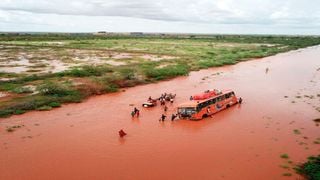
Vehicles stranded on a flooded stretch of the Isiolo-Mandera road following heavy rains last year.
| File | Nation Media GroupIsiolo
Premium
The Great North Road: How Sh83bn highway will open up northern Kenya
What you need to know:
- The route is notorious for the smuggling of arms and drugs as well as human trafficking.
- Several other projects are also on the cards, all billed to cost Sh111.7 billion.
Thousands of traders and businesses in northern Kenya are upbeat ahead of the construction of a 740-km Isiolo-Mandera highway that’s expected to boost security and open up the region to trade.
The Sh83.7 billion road will traverse Isiolo, Meru, Wajir, Garissa and Mandera counties, which are prone to terrorism, banditry and contraband.
The route is notorious for smuggling of arms, drugs and human trafficking. Its poor condition makes it difficult for security agencies to patrol.
Once complete, the road will cut travel time from Isiolo to Mandera from 96 to 12 hours and reduce vehicle operating costs as well as cut cost of commodities.
For instance, while a bag of cement costs Sh500 in Nairobi, in Mandera it retails at over Sh1,000 due to transport costs. A 740-km fibre optic cable will also be laid from Isiolo to Mandera.
The project will provide 3,000 direct jobs during construction and indirectly through food supplies and sub-contracting, he said.
Dubbed the Horn of Africa Gateway Development Project (HoAGDP), it’s part of the Vision 2030 Lamu Port South Sudan Ethiopia Transport (Lapsset) corridor in which Isiolo is to be transformed into a resort city.
Besides the Kenya National Highways Authority, other agencies involved are Information and Communication Technology Authority, National Transport and Safety Authority and Kenya Revenue Authority.
Grand plan
On Monday, the World Bank, the lead financier, launched the project in Isiolo with leaders from northern Kenya saying the road will be their “savour” after decades of marginalisation.
Present were governors Mohamed Kuti (Isiolo), Kiraitu Murungi (Meru), Mohamoud Ali (Marsabit), Ahmed Ali Muktar (Wajir), Ali Roba (Mandera) and deputy governors Abdi Dagane (Garissa) and Peter Emuria (Turkana).
The World Bank said the road was part of a grand plan to open up the northern region alongside other projects, which will cost US$1 billion (Sh110 billion). Other financing partners include the African Development Bank (AfDB) and a Consortium of five Arab lenders.
“There will be development of social infrastructure for the host community, including pastoralist roadside markets, clean water, extending electrification to selected centres, provision of milk coolers, slaughterhouses, veterinary posts and livestock holding areas in selected locations,” said a brief by KeNHA.
“The objective of the project is to enhance connectivity among the HoA countries and access to seaports; facilitation of domestic and regional trade and economic integration and road safety. The project will also enhance regional trade and improve transport of people and goods.”
Two new bridges will be constructed in Rhamu and Mandera as well as in One-Stop Border posts in the two towns. Mandera borders Ethiopia to the north and Somalia to the east.
The project has been divided into six sections, with funding for the first 190 kilometre section between Isiolo and Modogashe via Kulamawe already secured, KeNHA director-general Mr Kung’u Ndung’u said.
“Award of contracts for Isiolo-Kulamawe and Kulamawe-Modogashe is expected in three weeks with ground-breaking for building of that section expected in January. Preparations for other sections is ongoing and it is expected that the entire road to Mandera will be completed in the next five to six years,” he said.
World Bank representative Josphat Sassia said with completion of the project, the region will get lasting benefits by expanding access to livestock markets.
Transforming the region
“This is the first project the World Bank is financing in northern Kenya. This project will also support livelihoods of host communities through provision of public services and construction of complementary socio-economic infrastructure,” he said.
He said the bank will also support other projects under the North Eastern Development Initiative (NEDI).
“The journey to develop the region started in 2016 when the Office of the President presented a proposal. A team of exerts was put up and discussed projects that would be implemented, focusing on development of water resources, energy supply, transport and ICT and agriculture,” he said.
The University of Nairobi will coordinate social welfare programmes to ensure the projects benefit the community.
“People are the most important component of a project and UoN will contribute to capacity building among all the stakeholders and coordinate land acquisition and resettlement to ensure that the residents are at the centre of the project to avoid social disruption of the community,” said UoN vice-chancellor Prof Stephen Kiama.
Mr Kuti hailed the project as a big step towards transforming the region and urged residents to cooperate with agencies to actualise it, noting that the Isiolo-Moyale road had eased movement to the Ethiopia border.
Mr Murungi, whose county will host 72 kilometres of the new road, said Meru would immensely benefit from the project since it would be easy to transport farm produce to Mandera.
Last year, KeNHA signed a memorandum of understanding with the counties through which the road traverses in which the devolved units agreed to waive cess for construction materials and free movement of labour “in the spirit of development of the road corridor”.






